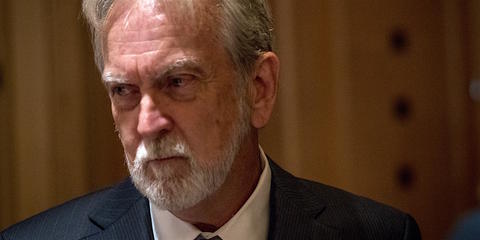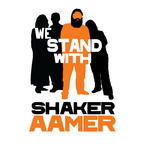As Torture Rears Its Ugly Head at Guantánamo, Let’s Not Forget That the Entire Prison Must Be Closed

CIA torture architect James Mitchell, questioned at Guantánamo in January 2020 (Photo: Angel Valentin/New York Times).
If you can, please make a donation to support our work in 2020. If you can become a monthly sustainer, that will be particularly appreciated. Tick the box marked, "Make this a monthly donation," and insert the amount you wish to donate.
By Andy Worthington, February 8, 2020
2020 has, to date, been noteworthy for how much attention has been focused on Guantánamo, the U.S. naval base in Cuba that is home to the "war on terror" prison established in January 2002, and also to the inappropriately named Camp Justice, where trial proceedings for some of the men held in the prison take place.
First up was the 18th anniversary of the opening of the prison, on January 11, when campaigners from numerous NGOs and campaigning groups — including Close Guantánamo — held a rally outside the White House to call for the prison’s closure. I flew over from the U.K. to take part in this rally, as I have done every year since 2011, and then stayed on for a week to take part in two speaking events, six radio interviews, and an interview with RT, the only TV interview in the whole of the U.S. broadcast media that dealt with the anniversary.
I returned to the UK on January 20, just as a second round of more prominent Guantánamo-related activity began at Camp Justice. For the first time in many years, dozens of journalists had flown to the naval base for the latest round — the 40th, astonishingly, since hearings began in 2012 — of pre-trial hearings for the proposed trial of Khalid Sheikh Mohammed and four other men accused of involvement in the terrorist attacks of September 11, 2001.
Often, in recent years, Guantánamo’s hardest-working reporter, Carol Rosenberg, who has been visiting and writing about the prison since it opened, initially for the Miami Herald, and most recently, for the New York Times, with the support of the Pulitzer Center, has been alone, or almost alone, in covering the commissions, but these particular hearings drew in crowds of reporters, because James Mitchell, one of the two architects of the CIA’s post-9/11 torture program (and who, with his colleague Bruce Jessen, was paid $81m for the privilege) was being questioned by defense attorneys for the five men.
The basis for the questioning involved evidence provided by the men during interrogations, and prosecutors’ assertion that they did not need to rely on statements made by the men in the CIA’s "black sites," where they had been subjected to torture, because they were, instead, using later confessions made by the men to "clean teams" of FBI agents, who had interrogated them after their arrival at Guantánamo in September 2006 without using any forms of coercion.
The defense attorneys have, since 2018, been establishing a rich seam of evidence demonstrating that the FBI liaised far too closely with the CIA for there to be any credibility to the "clean team" argument, but, when Mitchell’s questioning began, what came to the fore most particularly was the entirety of the torture program itself. This was both important and ironic, as, to date, the grindingly slow progress of pre-trial hearings for the men facing prosecution has been because, while the defense teams have been seeking to expose what happened to their clients in the CIA’s "black sites," prosecutors have been doing their utmost to try and keep all evidence of the men’s torture hidden.
In the many reports from the hearings, I was particularly impressed by an article for the Intercept by Margot Williams, a journalist and researcher who set up the New York Times' "Guantánamo Docket," which contains all the publicly-available files on the Guantánamo prisoners.
Torture and euphemism at Guantánamo
In an article entitled, "At Guantánamo Bay, Torture Apologists Take Refuge in Empty Code Words and Euphemism," Williams wrote:
Euphemism is a foundation of the torture structure. Even Mitchell railed against some of the words used by the government to describe the program he was pursuing: "You want to watch the use of euphemism for what you’re doing. Don’t be fooled by 'enhanced interrogation,' you are doing coercive physical techniques," he said last week. So there is a euphemism for the euphemism, which in plain English is torture.
As the testimony continues, euphemisms abound. There are code words for locations as well as code numbers and pseudonyms for names. An overlay of psychological terminology tries to give method and reason to examples of physical abuse. These phrases are used: "intelligence requirements," "abusive drift," "countermeasures to resistance," "Pavlovian response," "learned helplessness," "negative reinforcement," "conditioning strategy," a chart of "moral disengagement." Torturers used a technique known as "walling," in which a detainee is thrown against a wall that is described as "safe" because it is made of plywood and constructed to have "bounce." When walling was used, a beach towel was protectively wrapped around the prisoner’s neck and later became a "Pavlovian" tool that the detainee could be shown to remind him of the suffering he’d endured. This is how torturers speak, cloaking their actions in anodyne language.
During the hearings, CIA cables were either flashed on the overhead monitor if they had been declassified, or remained hidden from our view if they were still secret, recounting the number of slaps, the hours and days of sleep deprivation, the stopwatch counts of waterboard drownings, the rounds of "walling." The effect is deadening to the observer; it seems part of a bureaucracy of nightmares.
Despite this, Walter Ruiz, who represents Mustafa al-Hawsawi, one of the five men accused of involvement in the 9/11 attacks, finally used the word "torture" when questioning Mitchell. "I know torture’s a dirty word," Ruiz said, but added, "I’ll tell you what, judge, I’m not going to sanitize this for their concerns."
Later, after discussion of al-Hawsawi’s torture by other interrogators, Ruiz asked Mitchell, "Did it matter in your assessment that Mr. Al Hawsawi had been tortured in this many ways? Did it matter to you?" As Williams noted, "Mitchell objected to the characterization of Hawsawi’s treatment as 'torture,'" and the judge, Air Force Col. W. Shane Cohen, stated, "Of course he says no because he doesn’t think it is torture." However, Ruiz had the last word, when he "showed a video clip of a 2018 podcast in which Mitchell said: 'We never used the word torture. Because torture’s a crime.'"
It remains to be seen, however, whether all this discussion of torture will impact in any meaningful way on the Groundhog Day absurdity of the commissions, whose default position is the unresolvable tension noted above between the defense attorneys’ push for transparency, and the prosecutors’ obsession with secrecy.
Don’t forget the rest of the Guantánamo prisoners
In addition, while the spotlight was shining on the five men charged in connection with the 9/11 attacks, there seemed, sadly, to be little focus on the 35 other men who are still held at Guantánamo, with the exception of Abu Zubaydah, for whom the torture program was invented, and who, as the Washington Post explained in an editorial on January 27, "was 'waterboarded' so severely that he began having involuntary body spasms and began to cry," as Mitchell explained in Guantánamo, adding that he "choked up at the horrific spectacle," and yet "defiantly told the commission that he felt a 'moral obligation to protect American lives [that] outweighed the temporary discomfort of terrorists who had voluntarily taken up war against us.'"
The Post’s editorial was entitled, "We need to start paying attention to the fate of prisoners in Guantánamo Bay," and was a rare example of the mainstream U.S. media drawing the connection between the five men in Camp Justice and the 35 other men still held.
As the Post’s editors stated, "What seems beyond debate, now, is that the Guantánamo Bay episode has gone on for too long and at too high a cost to the United States, both in damage to our international reputation and to our actual goals in the war against terrorism. There are 40 detainees left at the prison, of an original total of 780. Of these, only two have been convicted by military commissions; seven others have been charged and face trial; three have been recommended for trial; and the rest [28 men in total] have not been charged but have been deemed impossible to transfer out for security or other reasons. And so dozens of men still live in limbo; unresolved, too, is the final accountability of Mr. Mohammed, who deserves judgment and punishment but whose case instead languishes in military commission purgatory."
The Post’s editorial concluded, "Little or no attention is being paid to this situation at the highest levels in either Congress or the executive branch, which is headed by a man who ran on a promise to bring more prisoners to Guantánamo Bay and do 'worse than waterboarding' if elected. As [James Mitchell’s] chilling testimony reminds us, though, there is much unfinished business still left from 9/11. And attention must be paid."
At "Close Guantánamo," we wholeheartedly support this call for "the Guantánamo Bay episode" to be brought to an end, and pledge to do what we can this election year to keep reminding the world that, while we must pay attention to the five men subjected to a broken trial system discredited by the use of torture, we must also not forget the other men still held at Guantánamo — the "high-value detainees," like Abu Zubaydah, who were also tortured in CIA "black sites" but haven’t even been charged, and the "lower-value detainees," held separately in Camp 6, who make up about half of the remaining 40 prisoners, and who also haven’t ever been charged with anything resembling a crime. They include five men unanimously approved for release by high-level U.S. government review processes under President Obama, but who were not freed before he left office, as well as other men who were nothing more than, at most, foot soldiers for the Taliban in an inter-Muslim civil war that predated the 9/11 attacks and the U.S.-led invasion of Afghanistan, and who are only still held because, throughout their long, unjust and sometimes brutal imprisonment at Guantánamo, they have embarked on hunger strikes, or have demonstrated a "bad attitude."
While torture ought to shock the conscience, we should also not forget that holding men forever without charge or trial is also profoundly unjust and unjustifiable.




